20+ SAMPLE Business Continuity Policy
-
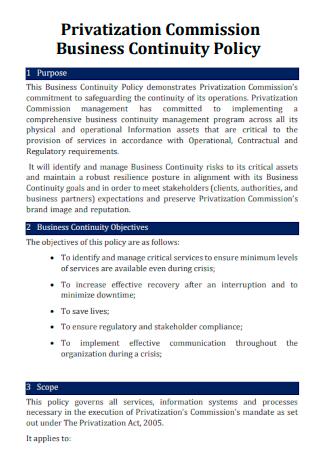
Privatization Commission Business Continuity Policy
download now -
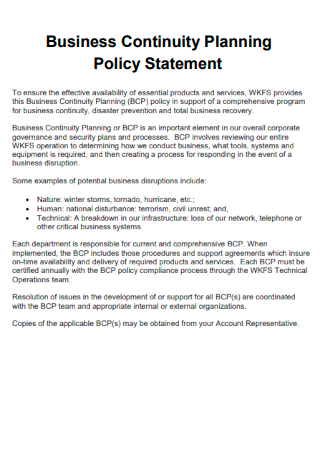
Business Continuity Planning Policy Statement
download now -
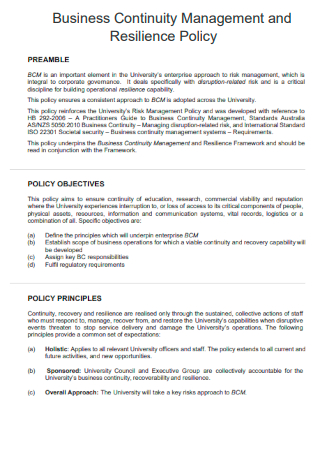
Business Continuity Management and Resilience Policy
download now -
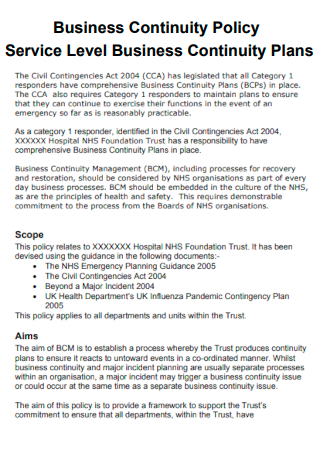
Business Continuity Policy Service Level Business Continuity Plans
download now -

Sample Business Continuity Policy
download now -
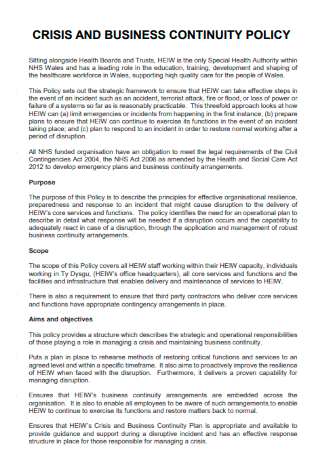
Crisis Business Continuity Policy
download now -
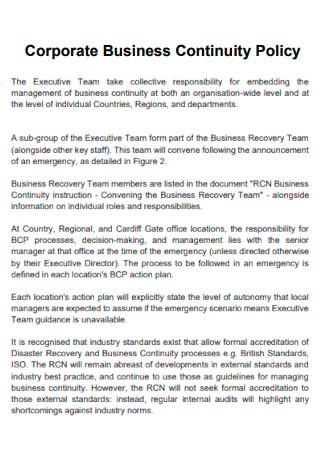
Corporate Business Continuity Policy
download now -
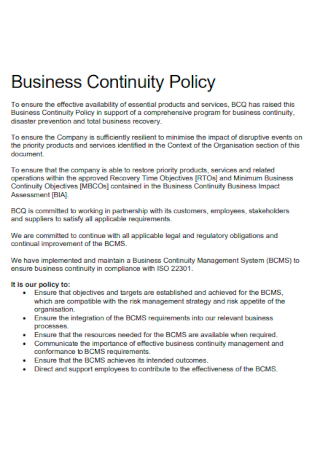
Basic Business Continuity Policy
download now -
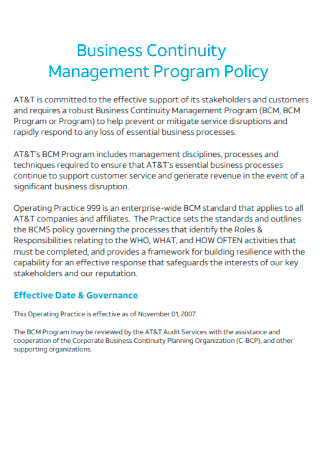
Business Continuity Management Program Policy
download now -
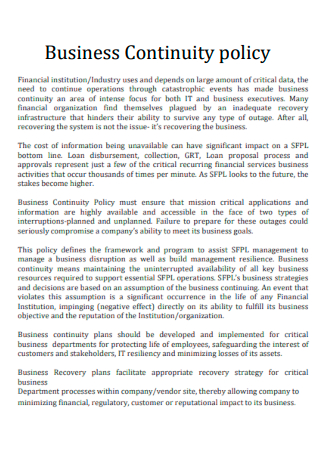
Formal Business Continuity Policy
download now -

Arts & Culture Business Continuity Policy
download now -

Business Continuity Policy Statement
download now -
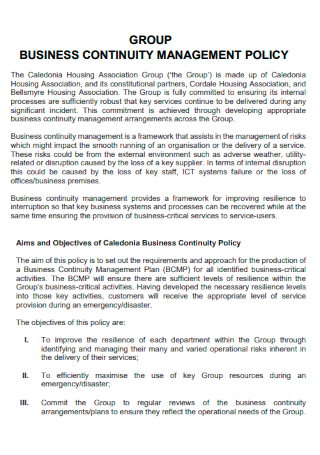
Group Business Continuity Management Policy
download now -
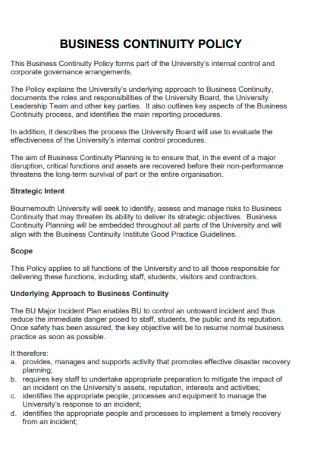
Printable Business Continuity Policy
download now -

Business Continuity and Disaster Recovery Policy
download now -
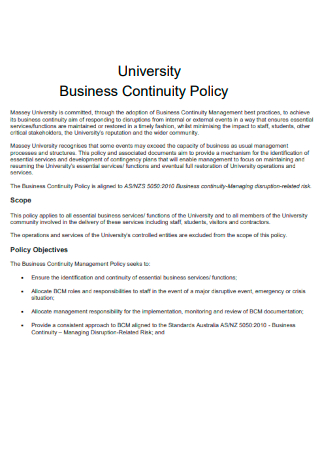
University Business Continuity Policy
download now -
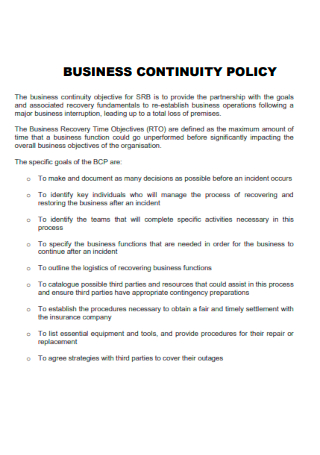
Editable Business Continuity Policy
download now -
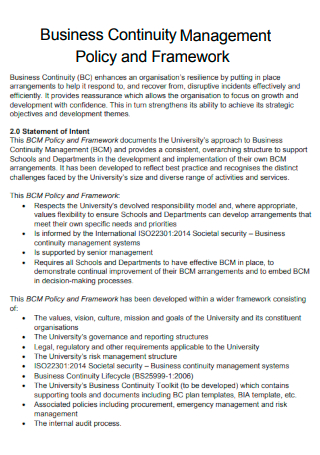
Business Continuity Management Policy and Framework
download now -
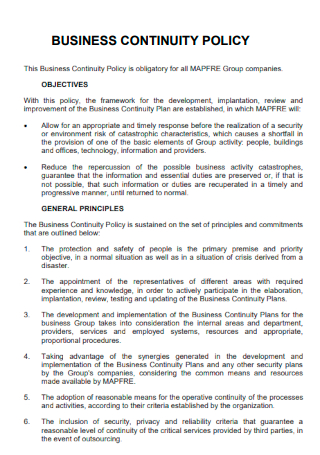
Example Business Continuity Policy
download now -
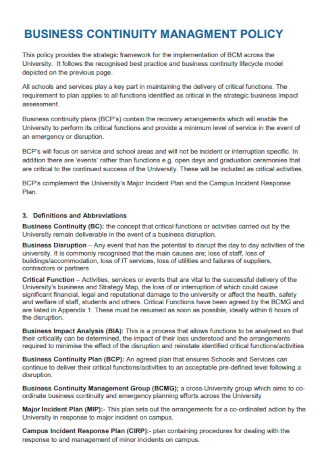
Simple Business Continuity Management Policy
download now -
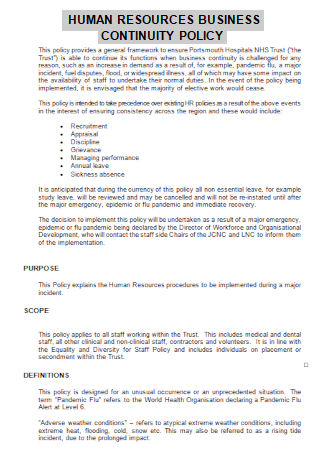
Human Resource Business Continuity Policy
download now
FREE Business Continuity Policy s to Download
20+ SAMPLE Business Continuity Policy
What Is a Business Continuity Policy?
Components and Structure of a Business Continuity Policy
How To Develop a Comprehensive Business Continuity Policy
FAQs
What are the three fundamental elements of business continuity?
What is a business continuity process?
What are the seven steps of continuity management?
What Is a Business Continuity Policy?
A business continuity policy is a set of measures and guidelines an organization follows to guarantee resilience and proper risk management. Business continuity policies vary through different organizations and industries, requiring periodic updates according to the development technologies and changes to business risks. The business continuity policy is a critical step in the information security program of the company and defines the essential steps that employees take to keep business operations and processes running smoothly despite facing a disruption event. The policy is a plan that addresses critical infrastructure, support plans, emergency contacts, and comprehensive recovery plans that a company uses to address possible threats. Companies can set realistic expectations for business continuity and disaster recovery procedures with a well-defined policy. The business continuity policy also determines the root cause of problems to address them properly. The creation and reinforcement of the plan fall in the jurisdiction of a company, following compliance and industry standards.
According to the BC Management Trends Report of 2021, over 22 percent of business continuity management programs report to risk management departments, growing to a total of 10 percent in 2009. The report also highlights that organizations, on average, have 16 professionals for business continuity programs.
Components and Structure of a Business Continuity Policy
For organizations to develop a comprehensive and effective business continuity policy, individuals must observe and research the policies of similar businesses in the industry, gathering much-needed information on what to include and not to include in the business document. Look at company websites, derive a structure, and read through the content of each section while taking note of the essential elements of a business continuity policy. The following section discusses the typical format for a business continuity policy that companies can use.
How To Develop a Comprehensive Business Continuity Policy
Business continuity policies demonstrate the goals and objectives of an organization in addressing the risks, problems, and issues that a business has the possibility of facing in the future. The organization focuses on creating simple yet attainable continuity goals by enacting plans and activities to find viable solutions and answers. Develop a comprehensive business continuity policy following the step-by-step process below and deliver the document to the members of an organization to know their respective roles and responsibilities when implementing the policy.
1. Construct a Business Continuity Team
For an organization to create a business continuity policy, it must first create a team consisting of a business continuity manager, business continuity plan coordinator, chief information security officer (CISO), chief technology officer (CTO), chief information officer (CIO), and the relevant stakeholders of the organization. It is necessary to create and develop a business continuity team to plan for the policy to get a range of inputs for different areas and matters, minimizing biased opinions towards specific business functions. The team allows an organization to have clear and concise communication methods, relaying only the most vital and relevant information between one another to develop a comprehensive document.
2. Draft the Policy Statement
The policy statement is a vital component of the business continuity policy that describes the purpose or aim of creating the policy from the beginning. Organizations must construct the policy statement as the starting point of the entire policy document. After completing the statement, the business continuity team performs group discussions, sets up team meetings, and conducts risk analysis and assessments to check if there is a necessity to make modifications or expansions to the current statement that they must incorporate to make it more specific and practical. The policy statement must have the purpose and scope of drafting the policy, contains a clear explanation of the framework of the business continuity management program, details the responsibilities and roles of individuals for the policy’s implementation, and introduces the monitoring process for policy compliance.
3. Conduct Risk Assessment and Business Impact Analysis
The business impact analysis or BIA is responsible for determining the financial and functional impact of possible problems or disruptions in an organization and reveals the key processes, procedures, and information about recovery time. Meanwhile, the risk assessment is responsible for identifying and ranking possible risks and threats in an organization. Business continuity policies are activities and plans that must be grounded in the company strategy, coming from senior management. When describing the scope and recovery parameters in an organizational policy, the business continuity team must also consider the turnaround time and the disruptions’ duration since they can affect the policy’s entirety.
4. Determine the Strategy for Business Continuity
A business continuity strategy provides a perspective view of the recovery and continuity plan the company wishes to implement and what it means to the company as a whole. The business continuity team must gather the necessary information and resources and consider the scope, approaches, and recovery timelines to craft a reliable business continuity strategy that the organization implements. Ensure that the company produces a clear and understandable business continuity strategy that enables the different members of the organization to perform their roles and responsibilities accordingly.
5. Write the Policy and Guarantee Stakeholder Buy-In
After determining the policy statement and the strategies that the business implements for its continual operations, it must document the scope, primary business facilities, and functions from the insight of the business impact analysis. It must also identify fundamental roles and responsibilities of individuals and the general approaches the business continuity team deems necessary for business continuity. If the CISO, CTO, and CIO are not part of the writing team, the business continuity manager must receive their input, suggestions, and expertise, including comments from third-party individuals and organizations relevant to the business.
6. Acquire Executive Endorsement and Promote the Business Continuity Policy
After writing the business continuity policy and getting the buy-in of stakeholders, the next step is to acquire the approval of senior executives and sponsorships that sets the business continuity planning procedure more manageable and successful in the long run. After all the necessary approvals and endorsements are complete, the next step is to share the business continuity policy document with employees and all other interested individuals. Organizations can promote the document in numerous ways, including posting the statement on bulletin boards, sending a virtual copy through company email, and producing a copy of the policy, handing it out to employees of different departments.
FAQs
What are the three fundamental elements of business continuity?
The three fundamental elements of business continuity include the recovery personnel, or the individuals having significant roles and responsibilities in the business continuity strategy, recovery procedure, which outlines the various methods and activities towards business continuity and lastly, data backup that includes financial documents, lists of fixed assets, and legal and statutory documents.
What is a business continuity process?
A business continuity process is a method of planning that a company performs to develop reliable prevention and recovery system from possible risks and threats, including cyber-attacks and natural disasters.
What are the seven steps of continuity management?
The seven steps that organizations must understand and perform to develop a business continuity plan include generating a regulatory review and landscape of an organization, performing risk assessments and business impact analysis, curating strategy and plan development, creating an incident response plan, conducting testing, training, and maintenance, and communicating the overall plan.
For an organization to become successful in its future endeavors, management and executives must prepare and develop business strategies that will help the organization deal with possible risks, threats, and problems stemming from business facilities, procedures, and operations. A business must create a team to perform a risk analysis, risk assessment, and business impact analysis to determine the financial and functional impact of these risks and threats to an organization and focus on the possible remediation plans to keep the business going. Developing a business continuity policy enables an organization to prepare for unpredictable events, containing measures and guidelines to guarantee resilience to risk. Create a reliable document for your business by downloading the templates available in the article only from Sample.net!
